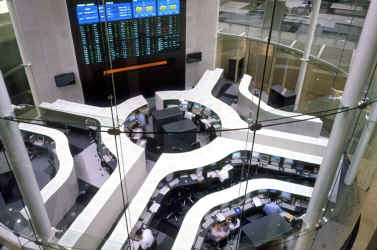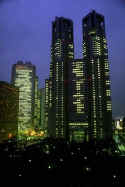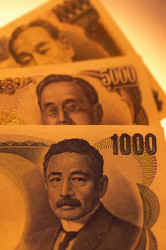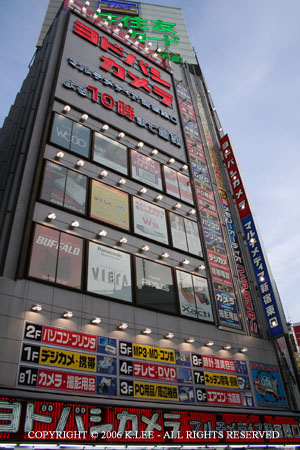|
Overview

The
second largest market economy in the world, Japan
has a per capita income that ranks third.
In 1996, it registered a gross domestic product
(GDP) of $4.63 trillion. Following the
collapse of the "bubble economy" in the
early 1990's, growth in the GDP has slowed.
With the vision of creating a more efficient
economy, Japan's government is currently promoting
deregulation of numerous economic sectors.
|
HIGH-GROWTH
ERA
Japan's
postwar economy developed from the remnants of an
industrial infrastructure that had suffered widespread
destruction during World War II. In 1952, at the
close of the Allied Occupation, Japan was a
"less-developed country," with a per capita
consumption roughly one fifth that of the United States.
Over the next twenty years, Japan was able to become the
first postwar-era country classified as
"less-developed" to achieve
"developed" status. In 1968, Japan's
economy became the world's second largest, behind only
that of the United States.
The
percentage of Japanese living in cities almost doubled
between 1950 and 1970, thus increasing demands for
services. During the 60's, Japan's average for
exports grew 18.4% per year. This economic growth
accompanied tremendous changes in Japan's industrial
structure. Whereas agriculture and light
manufacturing used to be the mainstays of the economy, now
it had shifted to heavy industry and services.
Dominating the industrial sector were iron and steel,
ship-building, machine tools, motor vehicles and
electronics.
Back to Top
A
MATURE ECONOMY
 Although
high growth rates were predicted for the 1970's,
double-digit inflation, the Middle East oil crisis, and
other factors, caused a recession which lowered future
growth expectations. This resulted in a reduction of
private investment and economic growth slowed to an
average of 3.6% from 1974-1979, a big drop from the 10% it
had previously experienced. There was a slight
increase in the 80's to 4.4%, but it was not until
recently that a positive change has come about, due to
many factors, including the "bubble economy." Although
high growth rates were predicted for the 1970's,
double-digit inflation, the Middle East oil crisis, and
other factors, caused a recession which lowered future
growth expectations. This resulted in a reduction of
private investment and economic growth slowed to an
average of 3.6% from 1974-1979, a big drop from the 10% it
had previously experienced. There was a slight
increase in the 80's to 4.4%, but it was not until
recently that a positive change has come about, due to
many factors, including the "bubble economy."
In spite of
the oil crisis and what happened, Japan's major export
industries remained competitive by cutting costs and
increasing efficiency. The energy demands were
reduced and the automobile industry was able to improve
it's position globally, by manufacturing lighter and more
economical vehicles. The second oil crisis in 1979
created a shift in Japan's industrial structure from
emphasis on heavy industry to development of new fields,
such as the computer, semiconductor, along with other
technology and information-intensive industries.
This started a period of rapid growth.
Back to Top
BUBBLE
ECONOMY
|

|
Following
the 1985 Plaza Accord, the yen rose sharply in
value over the next few years to three times its
value in 1971, in the fixed exchange rate
system. With the increase in the price of
Japanese exports, competitiveness was decreased
overseas, while government financial measures
increased demand domestically. |
Corporate
investment rose sharply in 1988 and 1989. New equity
issues rose in value as a result of higher stock prices,
thus making them an important source of financing for
corporations. In the meantime, banks sought for
funds in the outlet of real estate development. In
turn, corporations used their real estate holding as
collateral for stock market speculation. A direct
result of this was the doubling of land value prices and a
180% rise in the Tokyo Nikkei stock market index.
In May 1989,
the government tightened it's monetary policies to
suppress the rise in value of assets, such as land.
However, higher interest rates sent stock prices on a
steady spiral down. The Tokyo stock market had
fallen 38% by the end of 1990, thus effectively wiping out
2.07 trillion dollars in value. Steeply dropping
land prices burdened financial institutions with bad debts
and some of them even went bankrupt. Others
attempted to improve internal finances and managed to stay
afloat by limiting the supply of capital to private
businesses by being cautious in granting loans. In
October 1993, the recession bottomed out, but has been
recovering slowly since then.
Back to Top
THE
INDUSTRIAL SECTOR
Some people
expressed fears about the competitive capability of
Japanese industry due to the slow growth of the economy in
the late 90's. Technological innovation has enabled
Japan to regain a strong market position, in spite of the
US's stand at the forefront of the computer and computer
software industries. Although the US is making a
comeback in it's automobile industry, Japan has retained
it's position as a leader in the semiconductor and
automobile industries.
Influencing
the slow recovery of the Japanese economy was the sharp
rise in the value of the Japanese yen. Although the
yen has dropped since it's all time high in 1995, the
steep rise caused many Japanese companies in key import
industries to shift production overseas. This is
seen particularly in the automobile and electronics
industries. Assembly plants were opened in China,
Thailand and Malaysia and other countries for
manufacturers of electrical products such as TVs, VCRs and
refrigerators. This is because the work quality was
high, whereas the labor was inexpensive.
The process
of industrial and market globalization has resulted in
increases in the export of both component parts and
capital financing as well as in the import of finished
goods. Overseas production by Japanese manufacturers
now accounts for 10% of total production and is quickly
rising, although it is low in comparison to the US at 27%
and Germany at 17%.
Back to Top
POSTWAR
JAPAN
The primary
characteristic of Japan's postwar economy is the 15-year
period of high growth, beginning in the mid-1950's, that
enabled it to catch up with the developed economies of
Europe and the United States. The reasons for this
include high rates of both personal savings and
private-sector facilities investment, a labor force with a
strong work ethic, amply supply of cheap oil, innovative
technology, and effective government intervention in
private-sector industries. Japan was a major
beneficiary of the swift growth attained by the postwar
world economy, under the principles of free trade advanced
by the International Monetary Fund and the General
Agreement on Tariffs and Trade.
During this
period of high growth the competitive strength of Japanese
industry rose steadily. From the mid-1960s a current
balance surplus was achieved throughout the year, with the
exception of those years following the oil crisis of 1973.
In 1985, with net external assets of $129.9 billion, Japan
moved ahead of the United Kingdom to become the world
leader. During this same period, the United States
led the world in net external liabilities. Except
for 1990, when it was surpassed by Germany, Japan has
maintained this position as world leader.
Though it is
an understatement to say that Japan's economic growth was
based on its exports, it is a fact that exports and
private-sector facilities investment played an important
role during boom periods. Regardless of overseas
increases in demand, it is probable that the Japanese
economy could be revitalized by the stimulation of
domestic demand.
Back to Top

PROBLEMS
AHEAD
Japan's
prolonged economic troubles have been attributed to its
50-year postwar economic system. The Japanese
government is presently taking forthright structural
measures to deal with problems stemming from the bursting
of the economic bubble and the need for thorough changes
in order to accommodate industrial globalization.
The government is working to stabilize the nation's
financial system and revitalize the country's sluggish
economy. After several prominent financial
institutions declared bankruptcy in 1997, an
implementation of measures began in part in 1998.
Of concern is
Japan's growing number of the elderly. As the
population of the aged increases in future years, the work
force will be reduced. It will mean an increase in
social security demands as well as an increase in the tax
burden that workers will be expected to carry. It is felt
that an undermanned labor force is a possible factor in
the reduction of potential growth.
|
Economy - overview:
|
|
In the years following World
War II, government-industry cooperation, a strong
work ethic, mastery of high technology, and a
comparatively small defense allocation (1% of GDP)
helped Japan develop a technologically advanced
economy. Two notable characteristics of the
post-war economy were the close interlocking
structures of manufacturers, suppliers, and
distributors, known as keiretsu, and the guarantee
of lifetime employment for a substantial portion
of the urban labor force. Both features are now
eroding under the dual pressures of global
competition and domestic demographic change.
Japan's industrial sector is heavily dependent on
imported raw materials and fuels. A tiny
agricultural sector is highly subsidized and
protected, with crop yields among the highest in
the world. Usually self sufficient in rice, Japan
imports about 60% of its food on a caloric basis.
Japan maintains one of the world's largest fishing
fleets and accounts for nearly 15% of the global
catch. For three decades, overall real economic
growth had been spectacular - a 10% average in the
1960s, a 5% average in the 1970s, and a 4% average
in the 1980s. Growth slowed markedly in the 1990s,
averaging just 1.7%, largely because of the after
effects of inefficient investment and an asset
price bubble in the late 1980s that required a
protracted period of time for firms to reduce
excess debt, capital, and labor. The Japanese
financial sector was not heavily exposed to
sub-prime mortgages or their derivative
instruments and weathered the initial effect of
the recent global credit crunch, but a sharp
downturn in business investment and global demand
for Japan's exports in late 2008 pushed Japan
further into recession. Government stimulus
spending helped the economy recover in late 2009
and 2010, but Tokyo is warning that GDP growth
will slow in 2011. Prime Minister Kan's government
has proposed opening the agricultural and services
sectors to greater foreign competition and
boosting exports through free-trade agreements,
but debate continues on restructuring the economy
and funding new stimulus programs in the face of a
tight fiscal situation. Japan's huge government
debt, which is approaching 200 percent of GDP,
persistent deflation, and an aging and shrinking
population are major complications for the
economy.
|
|
|
GDP (purchasing power
parity):
|
|
$4.338 trillion (2010 est.)
country
comparison to the world: 4
$4.211 trillion (2009 est.)
$4.442 trillion (2008 est.)
note: data
are in 2010 US dollars
|
|
|
GDP (official exchange rate):
|
|
$5.391 trillion (2009 est.)
|
|
|
GDP - real growth rate:
|
|
3% (2010 est.)
country
comparison to the world: 125
-5.2% (2009 est.)
-1.2% (2008 est.)
|
|
|
GDP - per capita (PPP):
|
|
$34,200 (2010 est.)
country
comparison to the world: 39
$33,100 (2009 est.)
$34,900 (2008 est.)
note: data
are in 2010 US dollars
|
|
|
GDP - composition by sector:
|
|
agriculture: 1.5%
industry: 22.8%
services: 75.7%
(2009 est.)
|
|
|
Labor force:
|
|
65.64 million (2009 est.)
country
comparison to the world: 9 |
|
|
Labor force - by occupation:
|
|
agriculture: 4%
industry: 28%
services: 68%
(2009 est.)
|
|
|
Unemployment rate:
|
|
5.2% (2010 est.)
country
comparison to the world: 49
5.1% (2009 est.)
|
|
|
Population below poverty
line:
|
|
NA%
|
|
|
Household income or
consumption by percentage share:
|
|
lowest 10%: 4.8%
highest 10%: 21.7%
(1993)
|
|
|
Distribution of family
income - Gini index:
|
|
38.1 (2002)
country
comparison to the world: 74
24.9 (1993)
|
|
|
Investment (gross fixed):
|
|
20.3% of GDP (2009 est.)
country
comparison to the world: 83 |
|
|
Budget:
|
|
revenues: $1.839
trillion
expenditures: $2.252
trillion (2009 est.)
|
|
|
Public debt:
|
|
196.4% of GDP (2010 est.)
country
comparison to the world: 2
192.9% of GDP (2009 est.)
|
|
|
Inflation rate (consumer
prices):
|
|
-0.9% (2010 est.)
country
comparison to the world: 7
-1.4% (2009 est.)
|
|
|
Central bank discount rate:
|
|
0.3% (31 December 2009)
country
comparison to the world: 139
0.3% (31 December 2008)
|
|
|
Commercial bank prime
lending rate:
|
|
1.72% (31 December 2009 est.)
country
comparison to the world: 156
1.91% (31 December 2008 est.)
|
|
|
Stock of narrow money:
|
|
$5.541 trillion (31 December
2010 est)
$5.162 trillion (31 December
2009 est)
|
|
|
Stock of broad money:
|
|
$18.3 trillion (31 December
2009)
$14.56 trillion (31 December
2008)
|
|
|
Stock of domestic credit:
|
|
$16.39 trillion (31 December
2008 est.)
country
comparison to the world: 3
$13.32 trillion (31 December
2007 est.)
|
|
|
Market value of publicly
traded shares:
|
|
$3.378 trillion (31 December
2009)
country
comparison to the world: 3
$3.22 trillion (31 December
2008)
$4.453 trillion (31 December
2007)
|
|
|
Agriculture - products:
|
|
rice, sugar beets, vegetables,
fruit; pork, poultry, dairy products, eggs; fish
|
|
|
Industries:
|
|
among world's largest and
technologically advanced producers of motor
vehicles, electronic equipment, machine tools,
steel and nonferrous metals, ships, chemicals,
textiles, processed foods
|
|
|
Industrial production growth
rate:
|
|
7.5% (2009 est.)
country
comparison to the world: 33 |
|
|
Electricity - production:
|
|
957.9 billion kWh (2008 est.)
country
comparison to the world: 4 |
|
|
Electricity - consumption:
|
|
925.5 billion kWh (2008 est.)
country
comparison to the world: 4 |
|
|
Electricity - exports:
|
|
0 kWh (2008 est.)
|
|
|
Electricity - imports:
|
|
0 kWh (2008 est.)
|
|
|
Oil - production:
|
|
132,700 bbl/day (2009 est.)
country
comparison to the world: 49 |
|
|
Oil - consumption:
|
|
4.363 million bbl/day (2009
est.)
country
comparison to the world: 4 |
|
|
Oil - exports:
|
|
380,900 bbl/day (2008 est.)
country
comparison to the world: 34 |
|
|
Oil - imports:
|
|
5.033 million bbl/day (2008
est.)
country
comparison to the world: 3 |
|
|
Oil - proved reserves:
|
|
44.12 million bbl (1 January
2010 est.)
country
comparison to the world: 79 |
|
|
Natural gas - production:
|
|
3.539 billion cu m (2009 est.)
country
comparison to the world: 50 |
|
|
Natural gas - consumption:
|
|
94.67 billion cu m (2009 est.)
country
comparison to the world: 6 |
|
|
Natural gas - exports:
|
|
0 cu m (2008 est.)
country
comparison to the world: 84 |
|
|
Natural gas - imports:
|
|
90.29 billion cu m (2009 est.)
country
comparison to the world: 3 |
|
|
Natural gas - proved
reserves:
|
|
20.9 billion cu m (1 January
2010 est.)
country
comparison to the world: 76 |
|
|
Current account balance:
|
|
$182.3 billion (2010 est.)
country
comparison to the world: 2
$142.2 billion (2009 est.)
|
|
|
Exports:
|
|
$735.8 billion (2010 est.)
country
comparison to the world: 5
$545.3 billion (2009 est.)
|
|
|
Exports - commodities:
|
|
transport equipment, motor
vehicles, semiconductors, electrical machinery,
chemicals
|
|
|
Exports - partners:
|
|
China 18.88%, US 16.42%, South
Korea 8.13%, Taiwan 6.27%, Hong Kong 5.49% (2009)
|
|
|
Imports:
|
|
$636.8 billion (2010 est.)
country
comparison to the world: 5
$501.6 billion (2009 est.)
|
|
|
Imports - commodities:
|
|
machinery and equipment, fuels,
foodstuffs, chemicals, textiles, raw materials
|
|
|
Imports - partners:
|
|
China 22.2%, US 10.96%,
Australia 6.29%, Saudi Arabia 5.29%, UAE 4.12%,
South Korea 3.98%, Indonesia 3.95% (2009)
|
|
|
Reserves of foreign exchange
and gold:
|
|
$NA (31 December 2010 est.)
$1.024 trillion (31 December
2009 est.)
|
|
|
Debt - external:
|
|
$2.246 trillion (30 June 2010)
country
comparison to the world: 6
$2.231 trillion (31 December
2008)
|
|
|
Stock of direct foreign
investment - at home:
|
|
$161.4 billion (31 December
2010 est.)
country
comparison to the world: 24
$147.2 billion (31 December
2009 est.)
|
|
|
Stock of direct foreign
investment - abroad:
|
|
$831.1 billion (31 December
2010 est.)
country
comparison to the world: 7
$738.5 billion (31 December
2009 est.)
|
|
|
Exchange rates:
|
|
yen (JPY) per US dollar - 88.67
(2010), 93.57 (2009), 103.58 (2008), 117.99
(2007), 116.18 (2006)
|
Back to Top
|







